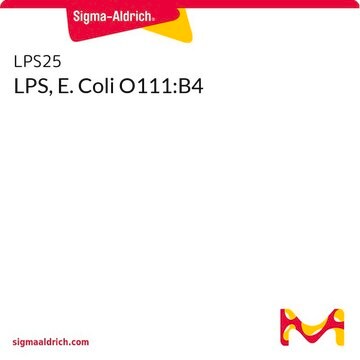Products may be shipped at a different temperature than the recommended long-term storage temperature. If the product quality is sensitive to short-term exposure to conditions other than the recommended long-term storage, it will be shipped on wet or dry-ice. If the product quality is NOT affected by short-term exposure to conditions other than the recommended long-term storage, it will be shipped at ambient temperature. As shipping routes are configured for minimum transit times, shipping at ambient temperature helps control shipping costs for our customers. For more information, please refer to the Storage and Transport Conditions document: https://www.sigmaaldrich.com/deepweb/assets/sigmaaldrich/marketing/global/documents/316/622/storage-transport-conditions-mk.pdf
推薦產品
生物源
Escherichia coli (O127:B8)
品質等級
無菌
γ-irradiated
產品線
BioXtra
形狀
lyophilized powder
純化經由
gel-filtration chromatography
技術
cell culture | mammalian: suitable
雜質
<1% Protein (Lowry)
溶解度
H2O: 5 mg/mL, slightly hazy
儲存溫度
2-8°C
尋找類似的產品? 前往 產品比較指南
應用
生化/生理作用
重構
相關產品
訊號詞
Danger
危險聲明
危險分類
Acute Tox. 2 Oral
儲存類別代碼
6.1A - Combustible acute toxic Cat. 1 and 2 / very toxic hazardous materials
水污染物質分類(WGK)
WGK 3
閃點(°F)
Not applicable
閃點(°C)
Not applicable
從最近期的版本中選擇一個:
分析證明 (COA)
客戶也查看了
文章
Explore the structure, function, and diverse applications of Lipopolysaccharides. Discover their role in bacteria, serological specificity, and research potential.
-
How is shipping temperature determined? And how is it related to the product storage temperature?
1 answer-
Helpful?
-
-
How can I determine the shelf life / expiration / retest date of this product?
1 answer-
If this product has an expiration or retest date, it will be shown on the Certificate of Analysis (COA, CofA). If there is no retest or expiration date listed on the product's COA, we do not have suitable stability data to determine a shelf life. For these products, the only date on the COA will be the release date; a retest, expiration, or use-by-date will not be displayed.
For all products, we recommend handling per defined conditions as printed in our product literature and website product descriptions. We recommend that products should be routinely inspected by customers to ensure they perform as expected.
For products without retest or expiration dates, our standard warranty of 1 year from the date of shipment is applicable.
For more information, please refer to the Product Dating Information document: https://www.sigmaaldrich.com/deepweb/assets/sigmaaldrich/marketing/global/documents/449/386/product-dating-information-mk.pdfHelpful?
-
-
Once reconstituted what is the stability at -20C for the LPS product L4516-1M?
1 answer-
Frozen aliquots can be stored up to 2 years. For more information, please see the link below:
https://www.sigmaaldrich.com/technical-documents/protocol/clinical-testing-and-diagnostics-manufacturing/bacteriology/lipopolysaccharidesHelpful?
-
-
Can LPS bind to plastics (ex. 1.5 mL microtube) even when LPS solution is frozen stored at -20℃? I store LPS solution at 0.05mg/mL in -20℃ now.
1 answer-
LSP is less likely to stick to plastics than glass, however very low concentrations (<0.1 mg/mL in water), LPS tends to stick to containers made
of certain types of glass or plastic. To minimize, prepare stock solutions of at least 1 mg/mL. If the LPS concentration is >1 mg/mL, adsorption to the sides of the vial is
negligible. For solutions stored in glass, vortexing for 30 minutes following thaw is recommended to redissolve. This may be useful for dilute solutions in plastic, as well. Surfaces (glass and plastics) may be salinized to reduce adherence.See Sigmacote, SL2:
https://www.sigmaaldrich.com/product/sigma/sl2For additional information, see the link below to review the Lipopolysaccharides product information page:
https://www.sigmaaldrich.com/technical-documents/protocol/clinical-testing-and-diagnostics-manufacturing/bacteriology/lipopolysaccharidesHelpful?
-
Active Filters
我們的科學家團隊在所有研究領域都有豐富的經驗,包括生命科學、材料科學、化學合成、色譜、分析等.
聯絡技術服務


